Would you ever believe that all the problems surrounding your wet and garden waste can be solved using steel mesh rings, a few cement slabs and some gunny sacks and also bring out loads of nice-smelling compost?
The answer is a resounding yes!
When Rainbow Residents’ Association President K P Singh wrote to me about their composting method describing its “simplicity and low cost”, I took it for just another method. But during my visit yesterday morning to this beautiful layout located on Sarjapur Road, it took seconds to realise what exactly he meant.
As simple as it gets
All simple and efficient things evolve with time and effort. Rainbow has tried various experiments but settled for this one for its two key features, the ones that KP mentioned.
It’s neither vendor-driven, nor machine-driven. This method exploits the traditional method of composting to the hilt but customises it perfectly to suit individual needs. While the infrastructure comes at a few thousand rupees, a few hundred rupees is all you spend each month to keep it running.
The infrastructure
You can construct the portable structures yourself without the help of any expert.
Put together a square-shaped platform using a few cement slabs. Leave some gap between each slab so that leachate, if any, drips down easily. Place a steel mesh plate on top of the slabs to prevent entry to the rodents from the bottom. Now, make a steel mesh ring or a pen of 3 ft diameter and 2.5 ft height. Both ends should be left uncovered. Place this ring on the platform. Wrap the pen with gunny sack to avoid the contents from spilling out and messing up the surroundings. This also prevents rodents from digging into the piles. Please note that there wasn’t any leachate leak at Rainbow. The dry leaves layers were absorbing all the moisture quite well.
I doubt if anyone can go wrong with this. But still, if you need more info, feel free to talk to K P Singh (contacts given below).
- As simple as it gets: A steel mesh ring wrapped with gunny sack cloth and raised on a platform.
- The leachate, if any, drips down to the earth while the substrate containing kitchen waste and dry leaves keeps decomposing in the container.
- Although very basic, this infrastructure efficiently tackles odour and rodent issues.
- This simple, cost-effective sieve serves well for a community of 250+ homes.
Space needed
A cluster of four such pens needs 8ftx8ft space. Four sets—a total 16 mesh ring containers—will need 20ftx20ft. This does not include space for curing. This set-up can easily serve 250-275 homes.
Suits large layouts
Rainbow Drive is a gated community built on a 34-acre landstrip dotted with 370 plots. Over 250 homes have already been occupied generating around 200 kgs of kitchen waste per day. It has a number of trees producing truckloads of dry leaves.
The process
Segregated kitchen waste is collected at the doorstep by a housekeeper in a pushcart. He carries a sack of sawdust in the cart and sprinkles a handful of it on the kitchen waste right at the pickup spot. This cuts down the moisture problem significantly. This half-processed waste reaches a roofed compost yard located in a corner. The worker spreads a thick layer of (at least 8-10 inches) dry leaves at the bottom and puts kitchen waste on top of it. This absorbs all the moisture content seeping down from the top layers efficiently. The top portion is always filled with dry leaves to ward off fruit flies, odour, mosquitoes and of course, rodents.
- Segregated waste is composted under this roofed yard.
- Kitchen waste sprinkled with sawdust is being spread on top of dry leaves.
- The staffer puts a layer of dry leaves on top of the kitchen waste.
- No need to turn the pile. Just the right measure of brown and green content laid out in layers.
Likewise, the layering goes on simultaneously in four containers. They can handle one week’s waste—almost 1.5 tonnes of segregated kitchen waste and a generous amount of dry leaves. There are four clusters of these mesh ring composters, each having four containers. In all, 16 mesh rings are enough to turn wet waste coming from 250-260 homes into compost. On the fifth week, the first set of containers is emptied out and the semi-compost is left to mature in the open ground. Those lacking space may simply let it lie in an airy, roofed corner for 2-3 weeks more before using it as manure. Constructing similar but larger mesh rings to store compost for curing is a good idea.
Why use sawdust
In any layering process, it is advisable to stick to equal measures of kitchen waste and dry leaves by weight, not volume. That means the voluminous dry leaves will take up a lot of space. You would need many more mesh rings to accommodate equal measures of both types of waste. Adding sawdust solves this problem with one shot. The consumption is low, but quite essential to the process.
No shredder used
KP, a Gandhian at heart, doesn’t believe in spending big on wet waste management but instead utilises natural elements to do the job. “We are a residential community. We cannot afford to spend lakhs on these processes. Although we bought a small shredder, we soon realised that the process can go on without it.”
Simply put, you don’t have to invest in a shredder. However, those bogged down by space constraints may use one to speed up the process.
What actually happens here
As you can see, there is no moistening or turning of the pile happening here. The moisture content comes from the kitchen waste alone. This seeps down to the lower level and kicks up microbial activity. Since the waste is not shredded, you will get some big chunks of semi-done compost after a month. At Rainbow, after sieving, the finer compost is given to the residents and coarser one is used for the common area gardens.
Dry leaves is an important ingredient
You will need loads of dry leaves for this process, or any method using open containers. Any apartment or layout with sufficient green cover can adopt this method without thinking twice.

KP Singh of Rainbow Drive proudly scoops up a handful of compost that smells like aromatic soil after summer rains. It has taken a lot of thinking and experimenting to simplify this composting process.
Aesthetics
Given how little is spent on the infrastructure and the entire process, this method may not score high on aesthetics. But large layouts can easily afford to mark off a small roofed corner and cover it with a shade net or a cluster of plants. Aesthetics begin to matter less if the process is easy, cost-effective and hassle-free. Whichever maybe the method, if the area is clean and hygienic, it will look neat.
The process is easy
No shredding needed, no turning of the piles either. Adding sawdust to the fresh wet waste and then layering it with dry leaves is all there is to be done.
No water or power consumption
You don’t have to sprinkle extra water on the piles. You don’t need power for shredding.
Odour issues
None.
Capex & opex
A few thousand rupees of capital expenditure to set up the entire system for 250-260 houses. Sawdust is the only recurring cost. Rainbow buys a few sacks of sawdust at Rs 30 each from a nearby timber yard.
Advantages
Quite a few. Low spending, easy process, quality compost and what not. You don’t have to spend on a contractor to load up the precious kitchen waste and dump it in a landfill. No waiting for him on days when strikes, vehicle breakdowns happen. And, you will get compost for your own gardens.
Contact details: K P Singh, 9845177160, Rainbow Drive Layout, opposite Wipro Corporate Office, Sarjapur Road, Bangalore – 560035.
***
Home-made compost for kitchen gardens
- M P Gopinath (left) and K P Singh pioneered various green initiatives for Rainbow Drive along with a few other committed volunteers.
- Gopinath’s home garden is nourished by the compost produced inside the gated community.
M P Gopinath is one of the pioneers and team-mate of KP Singh at Rainbow Drive who didn’t draw the line between personal and community work. In the last 3-4 years, I have visited quite a few communities. Almost without exception, I have seen each community blessed with at least a few such individuals who take the collective green quotient to a new high.
At home, Gopinath has a small garden dotted with pumpkin creepers, pepper, salad greens and some ornamentals growing on the compost produced in the community. While the resplendent green home garden stands testimony to the quality of the compost, the duo’s smiles and their no-holds-barred exchanges on what to achieve next speak volumes for their exuberant inner ecology.
For it’s always a rich inner ecology that helps a beautiful outer ecology take shape.



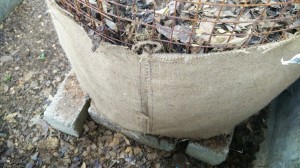
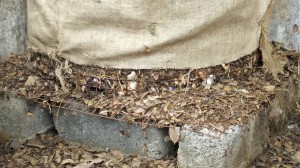




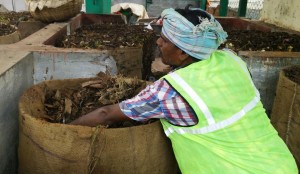



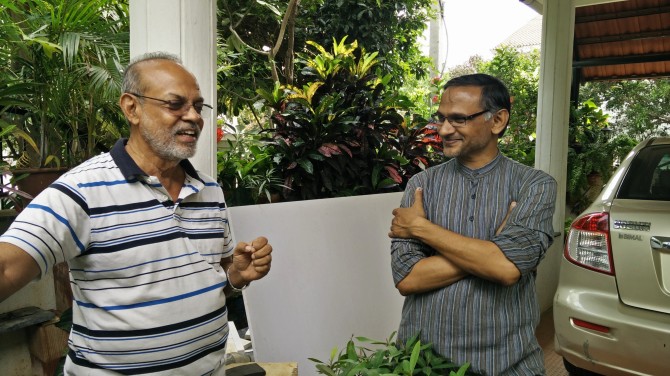
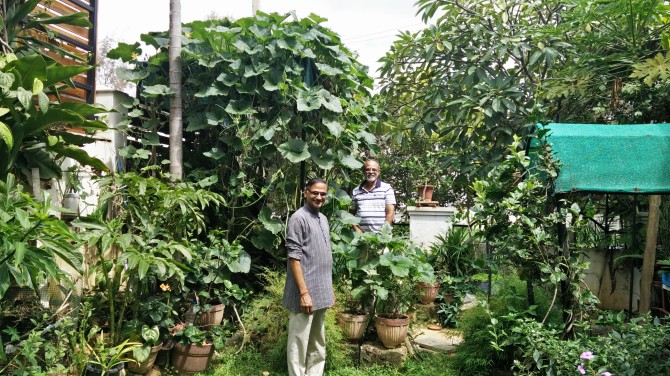


Thank you so much Savita for your visit to Rainbow Drive and sharing our way of composting with others who are looking out to / in the process of ‘owning’ their kitchen waste. Alongwith Mr Gopinath, a team of volunteers from Rainbow Drive, namely Mr Balaji, Mrs Bharati, Mrs Reetu Singh and few others have owned up the responsibility of handing the waste management. Credit goes to them for continuously striving to make the process simple and economical. Thanks again.
LikeLike
It was a nice experience to visit Rainbow, KP.
As you have rightly said, it always takes more than a few selfless volunteers to keep the work going. All these initiatives demand some degree of commitment from the residents. We can’t have them running successfully only through the staff members. They need to be motivated, too. Congratulations to Mr Balaji, Mrs Bharati, Mrs Reetu Singh and the rest of the volunteer team for their successful waste mgmt. May your tribe grow. 🙂
LikeLike
Effectiveness increases with simplicity!
LikeLiked by 1 person
You said it. 🙂
LikeLike
I just got the third request for visit Rainbow Drive to see this. Thanks Savita for playing great role in helping residents manage their own waste !
LikeLiked by 1 person
That’s gratifying, KP! The credit goes to all the Rainbow residents, volunteers and you for such a simple method. It must reach more people. Let’s hope it does. 🙂
LikeLike
Superb! Simple and effective. Thanks Savita for turning your passion for greenery into an impressive source of information.
LikeLiked by 1 person
All the time, effort and money poured into keeping this blog going become worthwhile when I receive a comment like this. Much thanks for your kind words, Bharath. 🙂
LikeLike
Thank you savita and Kp, we have been studying various systems for implementing in our RWa in gurgaon, this by far seems the most effective in most ways, ( especially composting both kitchen and horticulture waste at one go ) , Question : 1) since it gets quite cold in Gurgaon ( down to 2 degrees C ) how would that effect the composting ???, 2) can we add cooked food and non veg ??
hope to have a more detailed dialoque with KP Sir in due course
thank you
keshav
LikeLiked by 1 person
Hi Keshav, I have asked KP to reply to your comment. Why don’t you call him? I am sure he will be fine with that. Thanks for reading the post. 🙂
LikeLike
hello savita ,
you have done some amazing work on the community composting methods, I was wondering if you can do a comparitive chart ( i know more work ) giving the basic details and pros and cons, area required , approx costs of each method and also linking it your detailed article for each method. This would make it easier for people to identify 2 / 3 methods and study them at lenght . Unfortunately we all need handholding , regards
keshav chander jaini, Gurgaon
LikeLike
Hi Keshav, Believe it or not, this work has begun and since there are too many datapoints to work on, it’s taking time. I will blog it once it is ready. Thanks for the suggestion. 🙂
LikeLike
great , look forward to it , congrats on yr new article Re biofertiliser , very informative , have asked u a question in that post
LikeLiked by 1 person
Replied. 🙂
LikeLike
Keshav Jaini from Gurgaon called few days back to share that his first prototype composting turned out to be quite successful. He now has confidence to encourage the community to do take up segregation and full scale composting.
LikeLiked by 1 person
Yes, KP. Keshav has been updating all the progress. It’s nice to see this method going great even in places with extreme temperatures.
LikeLike
I loved the simplicity of the entire composting mechanism which would inspire other’s also to try it out. In my apartment also many are composting using earthen pots etc but this looks more manageable.
Also besides the wet waste we also need to take care of packaging wastes generated by various Ecommerce sites, would be glad to connect with you for the same and see if we can work together for some action. Here are my thoughts for the same.
http://www.stylebees.com/guilt-online-shopping-excessive-packaging-waste/
http://www.stylebees.com/reusing-cardboard-packaging-make-storage-boxes/
Thanks,
Swati
Email: stylebees@gmail.com
LikeLiked by 1 person
This is very nice and super method sir,this is important one in the world,this machine going clean to green,thank u sir.
LikeLike
Pingback: एक्सपर्ट सलाह: 100+ परिवारों वाली सोसाइटी कैसे बना सकती है कचरे से कई किलो खाद! - The Better India - Hindi